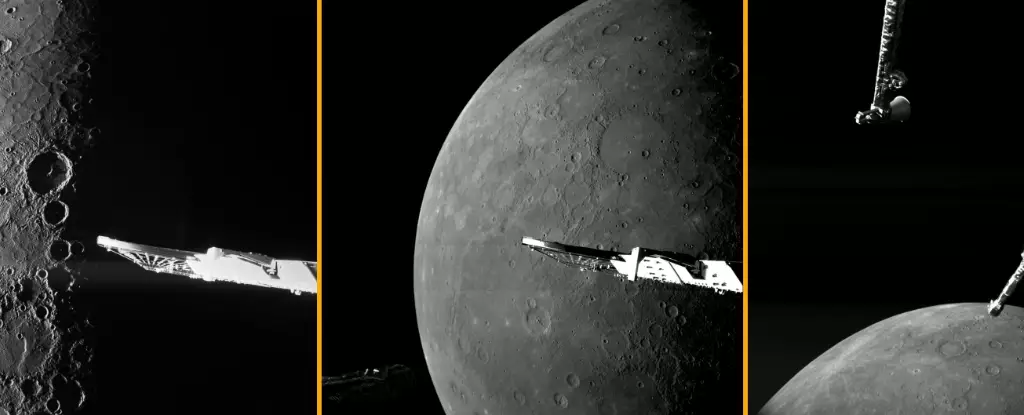BepiColombo, the European Space Agency’s ambitious mission to study Mercury, has recently achieved a significant milestone by completing its final flyby of the planet. Launched in 2018, the mission’s primary goal is to unearth the many secrets held within Mercury’s seemingly inhospitable surface and enigmatic environment. This flyby allowed BepiColombo to capture intricate images from just 295 kilometers above Mercury’s surface, providing a rare glimpse into a world characterized by extreme contrasts: blazing days transformed into chilling nights, all set against a backdrop of desolate craters and pronounced geological features.
The images captured during this flyby reveal not only the dramatic physical landscape but also hint at underlying mysteries that have baffled scientists for years. Permanent shadows that cloak certain craters are believed to harbor ice—an unusual occurrence on a planet so close to the Sun. These icy pockets may preserve crucial clues about Mercury’s history and its evolution over billions of years. European Space Agency Project Scientist Geraint Jones emphasized the importance of this data, stating that the team will dedicate the ensuing weeks to deciphering the myriad enigmas encapsulated within the images.
Despite the obstacles posed by Mercury’s harsh conditions, which include extreme thermal fluctuations that can reach up to 430 degrees Celsius during the day and plunge to an icy minus 180 degrees Celsius at night, BepiColombo has successfully navigated several gravitational assists to gain the momentum necessary for its primary exploration phase. This arduous journey culminates in a fully realized mission slated for 2027, where the findings from this flyby will serve as a prelude to a deeper examination of the planet’s characteristics.
As the smallest planet in our solar system and only marginally larger than the Moon, Mercury possesses intriguing properties that set it apart. Scorched by the relentless radiation from the Sun and assailed by solar winds, the planet’s surface is a harsh environment with a tenuous atmosphere. This thin veil of gases is continuously replenished, echoing the turbulent encounters with meteorites that batter the planet’s exterior. Unlike Earth, where atmospheric regulation stabilizes temperatures, Mercury’s extreme fluctuations expose the planet to striking contrasts between the searing heat of the sunlit side and the frigid darkness enveloping its shadowed regions.
The existence of a mysterious magnetic field doesn’t simplify our understanding; it creates further questions regarding Mercury’s internal structure and geological activity. Evidence suggests that the planet might possess a significant carbon reservoir, potentially existing as a layer of diamond beneath its surface. This tantalizing possibility suggests a rich, though cryptic, geological history marked by volcanic activity and dynamic processes.
The BepiColombo mission’s preliminary findings have already started reshaping our understanding of Mercury. Observations have revealed the Nathair Facula, noting signs of the planet’s largest volcanic activity, characterized by an expansive vent roughly 40 kilometers in diameter. Adjacent to this geological feature is the relatively young Fonteyn crater, which formed about 300 million years ago—indicating that Mercury’s surface is not as stagnant as once believed but rather subject to intermittent periods of renewal driven by catastrophic impact events and volcanic eruptions.
Looking ahead, the mission will transition to a phase where two orbital modules—the ESA’s Mercury Planetary Orbiter and the Japan Aerospace Exploration Agency’s Mercury Magnetospheric Orbiter—will commence independent investigations of the planet. Set to approach Mercury in 2026, these orbiters will provide a far closer examination from altitudes that are expected to enrich our understanding of the planet’s atmosphere, magnetic environment, and surface features.
As we prepare to delve deeper into the idiosyncrasies of Mercury through data collected by BepiColombo, the mysteries surrounding this brazen planet are gradually being peeled away. With each passing flyby and subsequent analysis, we stand on the brink of unprecedented insights into not just Mercury’s past but its potential future. BepiColombo is, undoubtedly, leading us on an exploratory journey that may redefine our comprehension of one of the solar system’s most enigmatic bodies.

